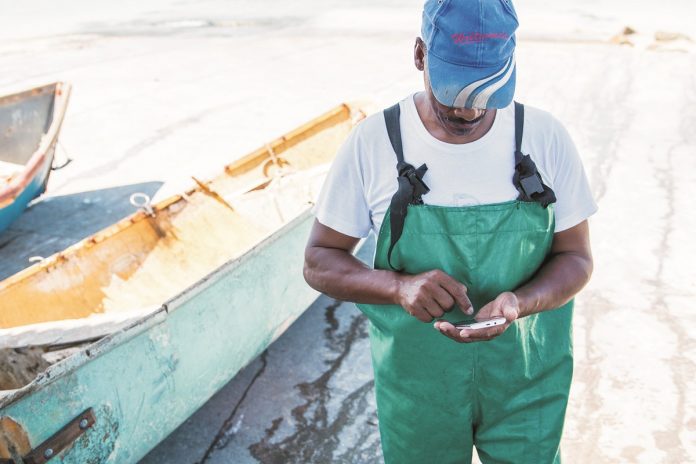
Nicholas P. Sullivan, Tufts University
People in the world’s developed nations live in a post-industrial era, working mainly in service or knowledge industries. Manufacturers increasingly rely on sensors, robots, artificial intelligence and machine learning to replace human labour or make it more efficient. Farmers can monitor crop health via satellite and apply pesticides and fertilizers with drones.
Commercial fishing, one of the oldest industries in the world, is a stark exception. Industrial fishing, with factory ships and deep-sea trawlers that land thousands of tons of fish at a time, are still the dominant hunting mode in much of the world.
This approach has led to overfishing, stock depletions, habitat destruction, the senseless killing of unwanted by-catch and wastage of as much as 30% to 40% of landed fish. Industrial fishing has devastated artisanal pre-industrial fleets in Asia, Africa and the the Pacific.
The end product is largely a commodity that travels around the world like a manufactured part or digital currency, rather than fresh domestic produce from the sea. An average fish travels 5,000 miles before reaching a plate, according to sustainable-fishing advocates. Some is frozen, shipped to Asia for processing, then refrozen and returned to the U.S.
But these patterns are starting to change. In my new book, “The Blue Revolution: Hunting, Harvesting, and Farming Seafood in the Information Age,” I describe how commercial fishing has begun an encouraging shift toward a less destructive, more transparent post-industrial era. This is true in the U.S., Scandinavia, most of the European Union, Iceland, New Zealand, Australia, South Korea, the Philippines and much of South America. https://www.youtube.com/embed/ZizIpLCQ_oM?wmode=transparent&start=0 Sustainable fishing limits catches at or below levels that fisheries can replace at their natural reproductive pace.
Fishing with data
Changes in behavior, technology and policy are occurring throughout the fishing industry. Here are some examples:
- Global Fishing Watch, an international nonprofit, monitors and creates open-access visualizations of global fishing activity on the internet with a 72-hour delay. This transparency breakthrough has led to the arrest and conviction of owners and captains of boats fishing illegally.
- The Global Dialogue on Seafood Traceability, an international business-to-business initiative, creates voluntary industry standards for seafood traceability. These standards are designed to help harmonize various systems that track seafood through the supply chain, so they all collect the same key information and rely on the same data sources. This information lets buyers know where their seafood comes from and whether it was produced sustainably.
- Fishing boats in New Bedford, Massachusetts – the top U.S. fishing port, based on total catch value – are rigged with sensors to develop a Marine Data Bank that will give fishermen data on ocean temperature, salinity and oxygen levels. Linking this data to actual stock behavior and catch levels is expected to help fishermen target certain species and avoid unintentional bycatch.
- Annual catch limits, divvied up through individual quotas for each fisherman, have helped curb overfishing. Imposing catch shares can be highly controversial, but since the year 2000, 47 U.S. stocks that were overfished and shut down have been rebuilt and reopened for fishing, thanks to policy judgments based on the best available science. Examples include Bering Sea snow crab, North Atlantic swordfish and red grouper in the Gulf of Mexico.
- A growing “fishie” movement that mirrors the widespread “foodie” locavore movement has been gaining steam for more than a decade. Taking a page from agriculture, subscribers to community-supported fisheries pay in advance for regular deliveries from local fishermen. Such engagement between consumers and producers is beginning to shape buying patterns and introduce consumers to new types of fish that are abundant but not iconic like the cod of yore.
Growing fish on land
Aquaculture is the fastest-growing form of food production in the world, led by China. The U.S., which has exclusive jurisdiction over 3.4 million square miles of ocean, has a mere 1% share of the global market.
But aquaculture, mostly shellfish and kelp, is the third-largest fisheries sector in the Greater Atlantic region, after lobsters and scallops. Entrepreneurs are also raising finfish – including salmon, branzino, barramundi, steelhead, eels and kingfish – mostly in large, land-based recirculating systems that reuse 95% or more of their water.
Industrial-scale ocean salmon farming in Norway in the 1990s was largely responsible for the perception that farmed fish were bad for wild fish and ocean habitats. Today this industry has moved to less dense deep-water offshore pens or land-based recirculating systems.
Virtually all new salmon farms in the U.S. – in Florida, Wisconsin, Indiana, and several planned for Maine and California – are land-based. In some cases, water from the fish tanks circulates through greenhouses to grow vegetables or hemp, a system called aquaponics.
There is heated debate over proposals to open U.S. federal waters, between 3 and 200 miles offshore, for ocean aquaculture. Whatever the outcome, it’s clear that without a growing mariculture industry, the U.S. won’t be able to reduce and may even widen its $17 billion seafood trade deficit.
A voracious China
This kind of progress isn’t uniform throughout the fishing industry. Notably, China is the world’s top seafood producer, accounting for 15% of the global wild catch as well as 60% of aquaculture production. Chinese fishing exerts huge influence on the oceans. Observers estimate that China’s fishing fleet may be as large as 800,000 vessels and its distant-water fleet may include up to 17,000 vessels, compared to 300 for the U.S.
According to a study by the nonprofit advocacy group Oceana using Global Fishing Watch data, between 2019 and 2021 Chinese boats carried out 47 million hours of fishing activity. More than 20% of this activity was on the high seas or inside the 200-mile exclusive economic zones of more than 80 other nations. Fishing in other countries’ waters without authorization, as some Chinese boats do, is illegal. Chinese ships often target West African, South American, Mexican and Korean waters.
Most Chinese distant-water ships are so large that they scoop up as many fish in one week as local boats from Senegal or Mexico might catch in a year. Much of this fishing would not be profitable without government subsidies. Clearly, holding China to higher standards is a priority for maintaining healthy global fisheries.
The ocean’s restorative power
There is no shortage of gloomy information about how overfishing, along with other stresses like climate change, is affecting the world’s oceans. Nonetheless, I believe it bears emphasizing that over 78% of current marine fish landings come from biologically sustainable stocks, according to the United Nations. And overharvested fisheries often can rebound with smart management.
For example, the U.S. east coast scallop fishery, which was essentially defunct in the mid-1990s, is now a sustainable US$570 million a year industry.
Another success story is Cabo Pulmo, a five-mile stretch of coast at the southeast end of Mexico’s Baja Peninsula. Once a vital fishing ground, Cabo Pulmo was barren in the early 1990s after intense overfishing. Then local communities persuaded the Mexican government to turn the area into a marine park where fishing was barred.
[Over 150,000 readers rely on The Conversation’s newsletters to understand the world. Sign up today.]
“In 1999, Cabo Pulmo was an underwater desert. Ten years later, it was a kaleidoscope of life and color,” ecologist Enric Sala, director of National Geographic’s Pristine Seas Project, observed in 2018.
Scientists say that thanks to effective management, marine life in Cabo Pulmo has recovered to a level that makes the reserve comparable to remote, pristine sites that have never been fished. Fishing outside of the refuge has also rebounded, showing that conservation and fishing are not incompatible. In my view, that’s a good benchmark for a post-industrial ocean future.
Nicholas P. Sullivan, Senior Research Fellow, Fletcher Maritime Studies Program, and Senior Fellow, Council on Emerging Market Enterprises, Tufts University
This article is republished from The Conversation under a Creative Commons license. Read the original article.
Read about : New Technology. Electronic Checks of Tori Lines
Consumer Power Needed to Help Solve the Lobster Crisis
From Hook to Cook. Coding for Crayfish in a Crisis




















Comments are closed.